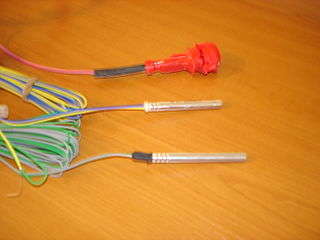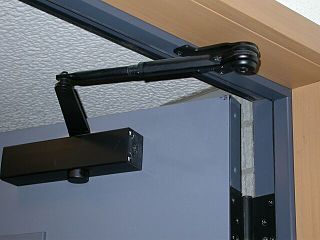Related Research Articles

A revolver is a repeating handgun that has at least one barrel and uses a revolving cylinder containing multiple chambers for firing. Because most revolver models hold up to six cartridges, before needing to be reloaded, revolvers are commonly called six shooters or sixguns. Due to their rotating cylinder mechanism, they may also be called wheel guns.

A detonator, sometimes called a blasting cap in the US, is a small sensitive device used to provoke a larger, more powerful but relatively insensitive secondary explosive of an explosive device used in commercial mining, excavation, demolition, etc.

The percussion cap, percussion primer, or caplock, introduced in the early 1820s, is a type of single-use percussion ignition device for muzzle loader firearm locks enabling them to fire reliably in any weather condition. Its invention gave rise to the caplock mechanism or percussion lock system which used percussion caps struck by the hammer to set off the gunpowder charge in rifles and cap and ball firearms. Any firearm using a caplock mechanism is a percussion gun. Any long gun with a cap-lock mechanism and rifled barrel is a percussion rifle. Cap and ball describes cap-lock firearms discharging a single bore-diameter spherical bullet with each shot.

A zipper, zip, fly, or zip fastener, formerly known as a clasp locker, is a commonly used device for binding together two edges of fabric or other flexible material. Used in clothing, luggage and other bags, camping gear, and many other items, zippers come in a wide range of sizes, shapes, and colors. In 1892, Whitcomb L. Judson, an American inventor from Chicago, patented the original design from which the modern device evolved.

A smoke bomb is a firework designed to produce a large amount of smoke upon ignition.
Needful Things is a 1991 horror novel by American author Stephen King. It is the first novel King wrote after his rehabilitation from drug and alcohol addiction. It was made into a film of the same name in 1993 which was directed by Fraser C. Heston. The story focuses on a shop that sells collectibles and antiques, managed by Leland Gaunt, a new arrival to the town of Castle Rock, Maine, the setting of many King stories. Gaunt often asks customers to perform a prank or mysterious deed in exchange for the item they are drawn to. As time goes by, the many deeds and pranks lead to increasing aggression among the townspeople, as well as chaos and death. A protagonist of the book is Alan Pangborn, previously seen in Stephen King's novel The Dark Half.

A joy buzzer is a practical joke device that consists of a coiled mainspring inside a disc worn in the palm of the hand. When the wearer shakes hands with another person, a button on the disc releases the spring, which rapidly unwinds creating a vibration which mimics an electric shock to the unsuspecting victim.

Door furniture or door hardware refers to any of the items that are attached to a door or a drawer to enhance its functionality or appearance.

The lock of a firearm is the mechanism used to initiate firing. It is a historical term, in that it generally refers to such mechanisms used in muzzle-loading and early breech-loading firearms. Side-lock refers to the type of construction, in which the individual components of the mechanism are mounted either side of a single plate. The assembly is then mounted to the stock on the side of the firearm. In modern firearm designs, the mechanism to initiate firing is generally constructed within the frame or receiver of the firearm and is referred to as the firing or trigger mechanism.

A novelty item is an object which is specifically designed to serve no practical purpose, and is sold for its uniqueness, humor, or simply as something new. The term also applies to practical items with fanciful or nonfunctional additions, such as novelty aprons, slippers, or toilet paper. The term is normally applied to small objects, and is generally not used to describe larger items such as roadside attractions. Items may have an advertising or promotional purpose, or be a souvenir.
Armstrong's mixture is a highly shock and friction sensitive primary explosive. Formulations vary, but one consists of 67% potassium chlorate, 27% red phosphorus, 3% sulfur, and 3% calcium carbonate. It is named for Sir William Armstrong, who invented it sometime prior to 1872 for use in explosive shells.

A cap gun, cap pistol, or cap rifle is a toy gun that creates a loud sound simulating a gunshot and smoke when a small percussion cap is ignited. Cap guns were originally made of cast iron, but after World War II were made of zinc alloy, and most newer models are made of plastic. Cap guns get their name from the small discs of shock-sensitive explosive compounds that provide the noise and smoke, effectively the same as the Maynard tape primer and percussion caps used in real firearms of the mid to late 1800s but usually smaller and made from cheap plastic or paper. Some are arranged in plastic rings of eight or twelve. There are also single caps, roll caps, disk caps, and cap strips all of which are actually extremely small versions of percussion fireworks. Armstrong's mixture is often used today as the explosive, but previously the tiny powder charge was a simple mixture of potassium perchlorate, sulfur, and antimony sulfide sandwiched between two paper layers that hold in the gases long enough to give a sound report when the cap is struck.
Soren Sorensen "Sam" Adams was a Danish-American inventor and manufacturer of novelty products, including the joy buzzer.

A practical joke or prank is a mischievous trick played on someone, generally causing the victim to experience embarrassment, perplexity, confusion, or discomfort. A person who performs a practical joke is called a "practical joker" or "prankster". Other terms for practical jokes include gag, rib, jape, or shenanigan.

A vial is a small glass or plastic vessel or bottle, often used to store medication in the form of liquids, powders, or capsules. They can also be used as scientific sample vessels; for instance, in autosampler devices in analytical chromatography. Vial-like glass containers date back to classical antiquity; modern vials are often made of plastics such as polypropylene. There are different types of vials such as a single dose vial and multi-dose vials often used for medications. The single dose vial is only used once whereas a multi-dose vial can be used more than once. The CDC sets specific guidelines on multi-dose vials.

A practical joke device is a prop or toy intended to confuse, frighten, or amuse individuals as a prank. Often, these objects are harmless facsimiles of disgusting or terrifying objects, such as vomit or spilled nail polish. In other instances, they are created as seemingly harmless items designed to humorously malfunction in such a way as to confuse or harm the target of a prank. The devices are frequently sold in magic or specialty shops, purchased over the Internet, or crafted for oneself. Perhaps the most notable such device is the whoopee cushion.
An acoustic mine is a type of naval mine which monitors audio activity in its vicinity. Depending on its design, it will either passively listen to its environment, depending only on the noise that is made by passing ships or actively send out audio pulses, not unlike a sonar, listening to the lapse in time in which the echo returns to it.

The revolver revolver was the first commercial repeating firearm employing a revolving cylinder with multiple chambers aligned with a single, stationary barrel. Its design was patented by Samuel Colt on February 25, 1836, in the United States, England and France, and it derived its name from being produced in Paterson, New Jersey. Initially this 5 shot revolver was produced in .28 caliber, with a .36 caliber model following a year later. As originally designed and produced, no loading lever was included with the revolver; a user had to partially disassemble the revolver to re-load it. Starting in 1839, however, a reloading lever and a capping window were incorporated into the design, allowing reloading without disassembly. This loading lever and capping window design change was also incorporated after the fact into most Colt Paterson revolvers that had been produced from 1836 until 1839. Unlike later revolvers, a folding trigger was incorporated into the Colt Paterson. The trigger became visible only upon cocking the hammer.
An exploding cigar is a variety of cigar that explodes shortly after being lit. Such cigars are normally packed with a minute chemical explosive charge near the lighting end or with a non-chemical device that ruptures the cigar when exposed to heat. Also known as "loaded cigars," the customary intended purpose of exploding cigars is as a practical joke, rather than to cause lasting physical harm to the smoker of the cigar. Nevertheless, the high risk of unintended injuries from their use caused a decline in their manufacture and sale.
References
- ↑ From Gags to Riches, by Joel Sayre. Scribner's Magazine, March 1941.
- ↑ Paul, Larry R. (2005). Made in the Twentieth Century: A Guide to Contemporary Collectibles. Scarecrow Press. p. 108. ISBN 9780810845633.